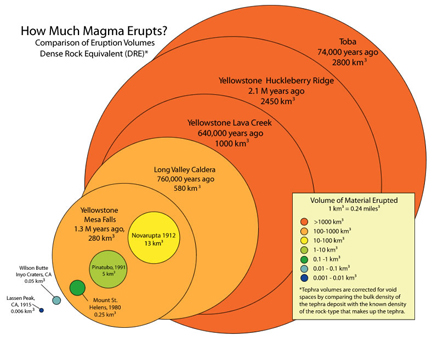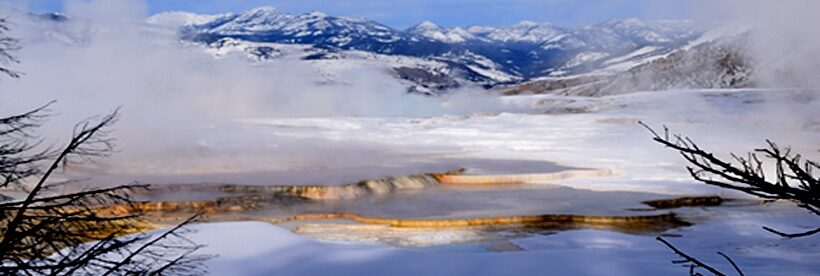
I give much thought to supervolcanoes – mainly because I live next to Yellowstone National Park and consequently spend much time in the Park. So when I saw today’s Nature publications about the cause of super-eruptions, naturally I wanted to read them.
I’ll first start with a definition for a supervolcano, and for that I’ll use one given by the U.S. Geological Survey:
The term “supervolcano” implies a volcanic center that has had an eruption of magnitude 8 on the Volcano Explosivity Index (VEI), meaning the measured deposits for that eruption is greater than 1,000 cubic kilometers (240 cubic miles). The VEI scale was created as a general measurement of the explosivity of an eruption. There are multiple characteristics used to give an eruption its VEI allowing for the classification of current and historic eruptions. The most common criteria are volume of ejecta (ash, pumice, lava) and column height. All VEI 8 eruptions occurred tens of thousands to millions of years ago making the volume of ejecta or deposits the best method for classification. An eruption is classified as a VEI 8 if the measured volume of deposits is greater than 1,000 cubic kilometers (240 cubic miles). Therefore a supervolcano is a volcano that at one point in time erupted more than 1,000 cubic kilometers of deposits.
Now to today’s online Nature publications for the cause of the eruption. There are two publications and each research team uses a different technique which results in finding two distinct causes for eruptions.
In the “Frequency and magnitude of volcanic eruptions controlled by magma injection and buoyancy“, Lucca and others use thermomechanical numerical modeling of magma injection into Earth’s crust and Monte Carlo simulations to observe:
We find that the rate of magma supply to the upper crust controls the volume of a single eruption. The time interval between magma injections into the subvolcanic reservoir, at a constant magma-supply rate, determines the duration of the magmatic activity that precedes eruptions.
Malfait and others, in their “Supervolcano eruptions driven by melt buoyancy in large silicic magma chambers“ publication, state:
Here we use synchrotron measurements of X-ray absorption to determine the density of silica-rich magmas at pressures and temperatures of up to 3.6 GPa and 1,950 K, respectively. We combine our results with existing measurements of silica-rich magma density at ambient pressures, to show that magma buoyancy can generate an overpressure on the roof of a large supervolcano magma chamber that exceeds the critical overpressure of 10–40 MPa required to induce dyke propagation, even when the magma is undersaturated in volatiles. We conclude that magma buoyancy alone is a viable mechanism to trigger a super-eruption, although magma recharge and mush rejuvenation, volatile saturation, or tectonic stress may have been important during specific eruptions.
As I said earlier, my proximity to Yellowstone has certainly made me take note of research relating to supervolcanoes. So I’m always glad to find ongoing work on them as well as their triggering mechanisms. Hopefully, better overall understanding of supervolcanoes will expand our capability to predict their super-eruptions.
